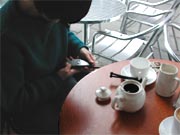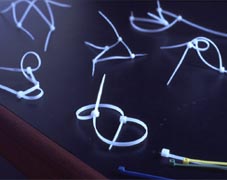D
A T A D O N O R
If you have a mobile phone, you could have up to 100 names and numbers stored in its memory. If every one of your contacts had the same number again, then at one remove you'd be part of a network of up to 10,000 individuals. Add two more steps, and you're up to a hundred million, more than most national populations. OK, most people haven't used all hundred, and there must be a fair degree of overlap (how many of your friends' friends are your friends?); but it's still a vast mesh of multiply interconnected individuals. What has been intriguing me is that with all of these names and numbers standardised electronic data, we could use the mobile phone as a device for enabling the mapping of this vast social space in all of its complexity. Only catch: there's no current way to access all the information. That's where Data Donor, a research project with a difference, comes in.


